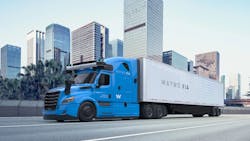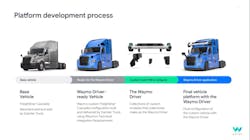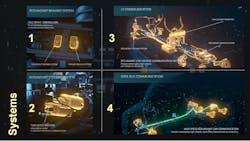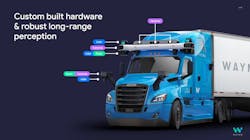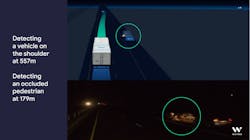Waymo to test autonomous Cascadia on public roadways
In the coming weeks, 240 miles of Interstate 45, between Dallas and Houston, will serve as a testing site for autonomous trucks
Two years ago, Waymo Via partnered with Daimler Truck to develop a redundant Level 4 (L4) autonomous truck platform for the Freightliner Cascadia powered by the Waymo Driver. Today, there is no production-ready, fully redundant autonomous Class 8 platform a fleet could buy from their dealer. Through its partnership, Daimler Truck has built an L4-ready system that incorporates Waymo technical requirements, which Waymo executives say have been "fine-tuned over several generations of autonomous driving systems" for both passenger and commercial vehicles.
"This platform brings compatibility with the Waymo Driver," explained Jason DiGrande, engineering lead for Waymo's OEM program, during an Aug. 23 executive roundtable with industry media. "It aligns system requirements and specifications, and testing requirements and specifications, and lastly, the implementing of the redundant features, such as steering and braking."To deliver on the Waymo Driver-ready Cascadia, Daimler executed more than 1,500 Waymo functional requirements based on learning done in programming for passenger cars and trucking platforms. As part of this work, Waymo provided Daimler with redundant power, redundant braking, and redundant steering functionalities. Waymo also provided cybersecurity, inertial measurements for vehicle positioning, and backup computing onboard the trucking platform.
See also: Daimler Truck to build scalable truck platform for autonomous driving
Initial testing for the autonomous-ready Cascadia occurred at the High Desert Proving Grounds in Madras, Oregon—about 120 miles southeast of Daimler Truck North America's Portland headquarters. Waymo is also putting its newly opened autonomous truck testing facility in Dallas to use for this project. The new facility is a transfer hub and an early endpoint of driverless routes, explained Boris Sofman, Waymo's head of engineering for trucking. It's the first custom-designed facility to accept and deploy autonomous trucks. When Waymo is ready to deploy this system as a product, this will be one of the company's main facilities to serve the Dallas area.
Daimler Truck also owns a majority share in Torc Robotics. Torc operates as an independent subsidiary for autonomous system development and testing with Daimler Truck's internal self-driving truck efforts.
Redundant systems, communications
Waymo's autonomous system's primary and secondary electronic braking system (EBS) controllers offer controls to decelerate the truck and the trailer. Should the primary EBS encounter any critical faults, the secondary EBS will take over to execute a minimal risk maneuver (MRM).
"Today, in a human-controlled vehicle, should there be any problems with the electronic control unit system, the driver gets notified and has the ability to use a pneumatic backup system to control the vehicle," Suman Narayanan, director of engineering at Daimler Truck North America, said. "Going forward, for a Level 4 autonomous vehicle, we must have a redundant brake controller that ensures should there be any interference with the brake controller, the redundant brake controller takes over and provides all the functionality of the analog braking system."
Redundant brake controllers have dedicated CAN Bus communication and dedicated low-voltage power, so at no point in time are they devoid of communication or power, Narayanan pointed out.In addition, electronic park brake (EPB) functionality provides the autonomous driving system (ADS) the ability to apply and release truck and trailer park brakes with CAN signals. That's so if there are any failures in the EPB that prevent the ADS from applying park brakes, CAN communication to the EBS will trigger the fallback protocol, using the EBS to pneumatically activate the parking brake.
When it comes to redundant steering, the steering gear is electronically assisted by two 8N.m servo motors that receive steering torque demand from the ADS and parallelly provide the requested steering angle and steering rate. DiGrande pointed out that Daimler put the servo motors into the platform for Waymo to execute a minimum risk maneuver (MRM) and take over the truck when needed.
Further, in the case of a hydraulic failure, the servo motors can provide adequate torque to execute an MRM.
"In case of a loss of power, for instance, we want to make sure that the truck has adequate stored power so that it can attain a safe state," Narayanan explained. "We increased the storage capability by adding batteries to the vehicle. A traditional Cascadia would have eight batteries. We increased that to 12."
How the Waymo Driver 'sees' its surroundings
Waymo sees itself as building the driver, not the truck itself, explained Boris Sofman, Waymo's head of engineering for trucking. The Waymo Driver system for trucks has a combination of lidar, radar, and cameras that complement one another and are customized to the unique shape of the truck.
Waymo Driver cameras detect outwards to a kilometer, so they can react faster to objects on the road, Sofman added. All these technologies are meant to be redundant so the truck can navigate through different weather conditions, single sensor failures, and other circumstances that occur on the road."Getting this prior notice of events is incredibly valuable to keep yourself out of situations and preemptively be defensive to change lanes for a blockage in the lane or for a vehicle stopped on the shoulder," Sofman said. "All of this becomes valuable for our ability to predict what sort of situations we will find ourselves in and stay out of challenging situations."
See also: Autonomous trucking: The benefits, challenges, and timeline
The system's next-generation radar functionality is particularly effective at dealing with weather conditions like rain and fog. It was designed for freeway driving needs—both in range and accuracy, Sofman pointed out.
"Weather is unpredictable," he said. "Our sensors, particularly the lidar, are good at estimating the types of conditions you're in—visibility of fog and density of rain. That influences how we regulate our wipers and maintain performance for the systems and models that are operating."
The overall autonomy system is broken down into three components: perception, prediction, and planning.
The first driverless route is going to be from Dallas to Houston. Each day, 11,000 trucks drive through it, Sofman pointed out, noting more challenging situations begin to emerge as the system nears metropolitan areas.
"We have trucks driving every single day in pretty large volumes, not just across this route, but other routes as well because we are building this driver to generalize well across different conditions," Sofman said. "Putting a lot of miles in is critical because a lot of challenges have a long tail of very rare conditions that we have to be able to deal with."
As an example, one night, the Waymo Driver detected a vehicle on the shoulder over 550 meters away that was preemptively changing lanes. At the same time, a occluded pedestrian close to 200 meters away was detected, and the system was able to react."Oftentimes, we are seeing these situations and obstacles before a human would," Sofman said. "A lot of times, drivers are being surprised by how well we are detecting these situations, and the truck starts changing lanes, and then [the human safety driver] only realizes in 200 meters why—because their view was [compromised] or they couldn't see at nighttime, and our the lidar picks up these signals effectively."
What's next?
Currently, Waymo owns and operates a test fleet of Cascadia trucks. Before getting to scalable, fully autonomous commercial deployment, Waymo will test autonomous driving on public roads, conduct pilots with test fleets, and eventually move from a Waymo-owned and operated fleet to one where a customer could purchase a truck equipped with the Waymo Driver directly from Daimler Truck.
Waymo is currently partnering with C.H. Robinson, Uber Freight, J.B. Hunt, and Ryder. The end goal is to build relationships with customers and run pilots that will represent the exact product that the company plans to launch, Sofman added.
"The first set of trucks that will be hitting the road were built in our Waymo Detroit facility," DiGrande said. "Daimler shipped the vehicle to our Detroit facility, and it was installed with the Waymo Driver. That was the first stage. As we look at full-scale deployment, we are flexible to being able to scale this in a production environment."
Narayanan emphasized that Waymo and Daimler are developing these systems as "we go along," adding that these are not yet start-of-production ready braking, power, and steering systems. The technologies still must go through preliminary federal motor carrier safety standards testing to ensure these vehicles are safe and always controllable by the safety driver.
Sofman said the company plans to launch its first driverless Waymo Driver in the next few years.
Moving forward, Daimler Truck will eventually handle the full build of these trucks, with Waymo supplying the components for the autonomous driving system. As development testing continues, Waymo will handle sensor maintenance in its facilities.
"Over time, we would lean into our various partnerships to handle that as we scale the network as we branch out to more and more territory," Sofman explained. "That allows us to really focus on setting up that foundation to enable that scale and focus on the Waymo Driver."
About the Author

Cristina Commendatore
Cristina Commendatore is a past FleetOwner editor-in-chief. She wrote for the publication from 2015 to 2023.
